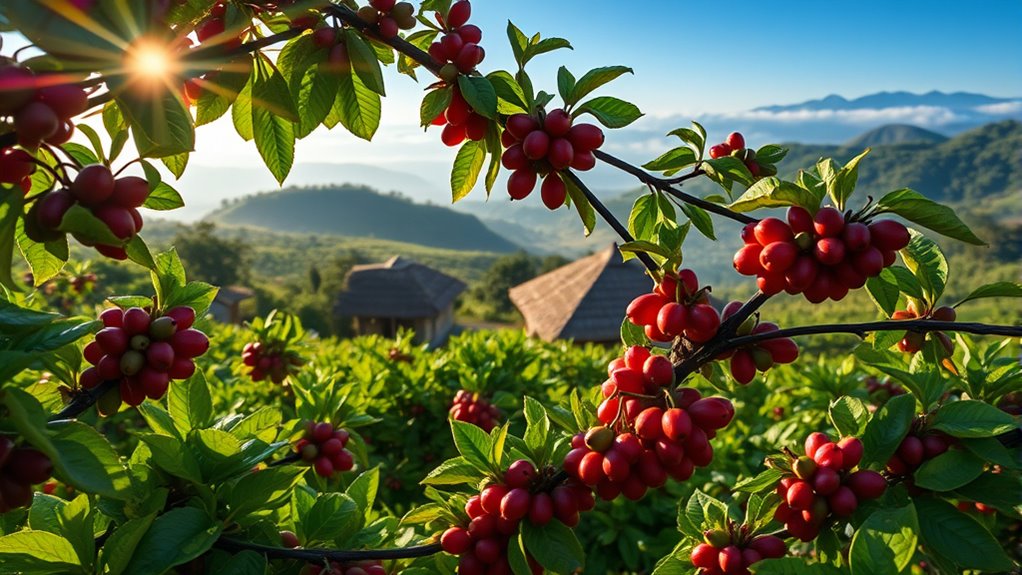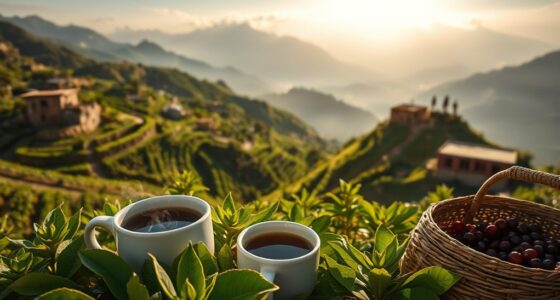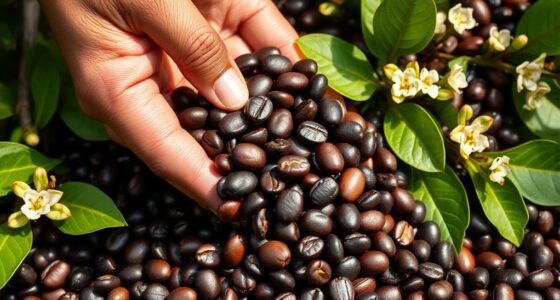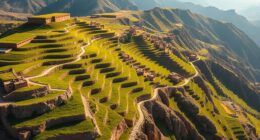Exploring Burundi’s coffee from Kayanza and Ngozi reveals vibrant, complex flavors with bright acidity that reflect the region’s unique terroir. Traditional processing methods, like careful washing and sun-drying, help preserve these distinctive qualities. The coffee plays a crucial role in local culture, with community-driven ceremonies and rituals that deepen your connection to the land and heritage. Discover more about the rich traditions and craft behind each cup as you continue exploring this special region.
Key Takeaways
- Kayanza and Ngozi produce high-quality Arabica coffee with bright acidity and complex, vibrant flavors reflecting regional terroir.
- Traditional processing methods, including careful washing and drying, preserve the beans’ unique flavor profiles.
- Coffee cultivation is deeply rooted in local culture, involving community-based harvesting and family-run farms.
- Coffee ceremonies, featuring roasting, grinding, and brewing, strengthen community bonds and uphold cultural traditions.
- The region’s coffee reflects Burundi’s heritage, showcasing a close connection between land, tradition, and quality.

Burundi coffee is renowned for its bright acidity, complex flavor profile, and vibrant aroma. When you explore coffee produced in regions like Kayanza and Ngozi, you get a vivid taste of how local practices shape each cup. Coffee farming in these areas is deeply intertwined with the country’s cultural traditions, making each harvest a reflection of community values and history. You’ll notice that coffee cultivation isn’t just an economic activity; it’s an essential part of daily life and identity. Farmers often pass down techniques through generations, maintaining a close connection to their land and heritage. This continuity ensures that the coffee you enjoy carries the richness of Burundi’s cultural legacy.
Burundi coffee reflects rich cultural traditions and community values, with each cup telling a story of land, heritage, and shared craftsmanship.
In these regions, coffee farming begins with meticulous attention to detail. Farmers select high-quality Arabica beans, often grown on small, family-run plots. They tend to their crops with care, using traditional methods that have been refined over decades. For many, the harvest season is a communal event, filled with shared labor and celebration. You’ll see farmers picking ripe cherries by hand, ensuring only the best beans are collected. After harvesting, processing methods—such as washing and drying—are carried out with care, influenced by local customs and expertise. This hands-on approach preserves the beans’ unique flavor qualities and highlights Burundi’s dedication to quality. Additionally, cultural traditions like coffee ceremonies play a vital role in community bonding and preserving heritage.
Cultural traditions are woven into every step of the coffee journey. Coffee ceremonies are common, serving as social gatherings that strengthen community bonds. These rituals often involve roasting beans over open flames, grinding them by hand, and brewing coffee in special pots. Participating in these ceremonies offers insights into Burundi’s hospitality and respect for tradition. As you taste the coffee, you’re experiencing more than just flavor—you’re engaging with a cultural narrative that spans generations. The practices around coffee farming and processing are preserved with pride, and they influence the distinctive profiles of Kayanza and Ngozi beans.
Ultimately, your appreciation of Burundi coffee deepens when you understand its cultural roots. It’s a product of not only environmental conditions but also the resilience and pride of local communities. From planting to processing, each step is shaped by traditions that have stood the test of time. When you sip on a cup from Kayanza or Ngozi, you’re participating in a cultural exchange—one that celebrates the harmony between people, land, and history. This connection makes Burundi coffee more than just a beverage; it’s a story brewed into every cup, waiting for you to discover.
Frequently Asked Questions
What Is the Best Time of Year to Visit Burundi for Coffee Tours?
The best season to visit Burundi for coffee tours is during the dry season, from June to September. During this time, the weather is pleasant, with less rain, making travel and farm visits easier. You’ll enjoy clear skies and cooler temperatures, ideal for exploring coffee plantations comfortably. Avoid the rainy season, from October to May, when heavy rains can disrupt tours and make conditions less favorable.
Are There Any Local Coffee Festivals or Events in Kayanza and Ngozi?
Yes, you can attend lively coffee festivals and local celebrations in Kayanza and Ngozi. These events showcase Burundi’s rich coffee culture through tastings, traditional music, and dance. Participating in a coffee festival gives you an authentic experience of the local community’s passion for coffee. Be sure to check the event schedules in advance, as these festivals typically align with harvest seasons, making your visit even more special.
How Do Local Farmers Cultivate and Harvest Coffee in These Regions?
Carefully cultivating coffee, local farmers in Kayanza and Ngozi use traditional techniques like hand-picking and selective harvesting. You’ll see them meticulously monitoring ripeness, ensuring only the best beans are harvested during peak seasons. These farming techniques emphasize patience and precision, as farmers pick ripe cherries at the perfect moment, then process them with care. This dedicated dedication delivers delightful, distinctive coffee that captures the region’s rich, invigorating flavor and vibrant vitality.
What Sustainability Practices Are Common Among Burundi Coffee Producers?
You’ll find that many Burundi coffee producers prioritize sustainability through organic farming practices, avoiding synthetic chemicals to protect the environment. They often pursue fair trade certification, ensuring fair wages and better working conditions for farmers. These practices support local communities, promote eco-friendly methods, and produce high-quality coffee while respecting the land. By choosing coffee with these certifications, you help sustain both the environment and the livelihoods of farmers in Kayanza and Ngozi.
Can Tourists Participate in Coffee Tasting or Brewing Workshops Locally?
Imagine stepping into lush coffee farms where you can join coffee tasting and brewing workshops. Yes, tourists like you can actively participate in these experiences, learning to appreciate Burundi’s rich flavors and brewing techniques firsthand. These workshops often offer guided tastings, hands-on brewing lessons, and cultural insights, making your visit more immersive. So, don’t hesitate—your coffee adventure awaits, blending education with the beauty of Burundi’s vibrant coffee heritage.
Conclusion
Now that you’ve explored Kayanza and Ngozi, you’re like a traveler with a map, ready to savor Burundi’s coffee treasures. These regions are the heartbeat of premium beans, each cup bursting with flavor and history. Just as a well-tended garden blooms beautifully, Burundi’s coffee reflects the care and passion of its farmers. So, when you sip, remember you’re tasting a piece of Burundi’s vibrant landscape—rich, unique, and full of life.









